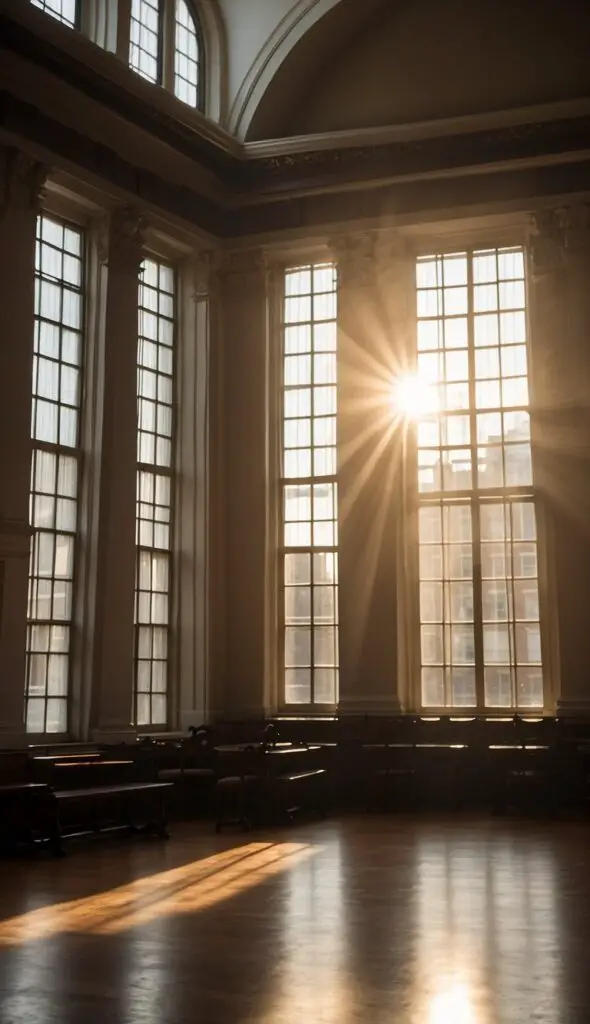Independence Hall, a storied structure in the heart of Philadelphia, holds a monumental place in United States history. It was within these walls that pivotal moments in the nation’s founding occurred, including the adoption of the Declaration of Independence and the U.S. Constitution by America’s Founding Fathers. The hall, completed in 1753, originally served as the Pennsylvania State House but evolved into much more, eventually becoming a symbol of liberty and governance that helped shape the burgeoning nation.

This historic building is a testament to the nation’s dedication to the principles of freedom and democracy. It forms the centerpiece of the Independence National Historical Park and has been recognized globally for its significance and influence, becoming a UNESCO World Heritage Site in 1979. Independence Hall’s design is an outstanding example of Georgian architecture, reflecting the values and aesthetic preferences of an era that valued symmetry and balance.
Key Takeaways
- Independence Hall is iconic for its historical decisions including the Declaration of Independence and U.S. Constitution.
- The site is integral to American governance and the spread of democratic ideals.
- Preservation and education efforts ensure the hall’s legacy endures for future generations.
Historical Significance
Independence Hall in Philadelphia is a pivotal landmark in United States history. Two key documents, the Declaration of Independence and the U.S. Constitution, were both debated and adopted here, earning the building the title of the “Birthplace of America.”
Declaration of Independence
The Declaration of Independence was adopted on July 4, 1776, within the walls of Independence Hall. This critical document announced the thirteen American colonies’ separation from British rule and outlined the principles of individual rights and freedoms that would become cornerstones of American democracy.
Constitutional Convention
In the summer of 1787, Independence Hall was the site of the Constitutional Convention, where the U.S. Constitution was debated and created. This enduring framework of governance established a system of federalism and checks and balances that remains in force today.
Birthplace of America
Independence Hall is often referred to as the Birthplace of America, for it was here that the United States came into existence as a sovereign nation. The decisions made within this edifice laid the foundation for the country’s future governance and ideologies.
UNESCO World Heritage Site
In recognition of its extraordinary significance, Independence Hall was designated a UNESCO World Heritage Site in 1979. The site is lauded for its universal principles of freedom and democracy, which have had a considerable influence on lawmakers and civic leaders worldwide.
Architecture and Design
Independence Hall in Philadelphia is famous not just as a site of significant historical events but also for its architectural features. It showcases the 18th-century Georgian style while reflecting the combined efforts of its architects.
Georgian Style
The Georgian style of Independence Hall is characterized by its emphasis on symmetry, proportion, and balance. This design is reminiscent of a country house more than an urban public building, which was a distinct choice of the period. Georgian architecture typically features a panelled front door centered with rectangular windows over the top, which can be seen in Independence Hall’s facade.
Edmund Woolley and John Haviland
Andrew Hamilton, a lawyer and politician, oversaw the project, ensuring the hall would serve both as the Pennsylvania State House and a symbol of liberty. Edmund Woolley, one of the original architects, is credited with the design and construction of the building, laying the foundations for this Georgian masterpiece. Nearly 70 years later, John Haviland played a significant role, not in the original construction, but in the addition of the clock tower in 1828, which was a functional enhancement to the structure and an architectural response to the original wooden steeple’s deterioration. Both architects’ contributions were crucial in creating the enduring legacy of the architecture of Independence Hall.
Independence Hall Complex
The Independence Hall Complex, part of the wider Independence National Historical Park, serves as a central point for American history, incorporating the iconic Liberty Bell, Congress Hall, and Old City Hall. These buildings are central to Independence Square and are situated along or near Chestnut Street, each playing a pivotal role in the birth of the United States.
Liberty Bell
Within the Independence Hall Complex is the Liberty Bell, an enduring symbol of American freedom. Once housed in the steeple of Independence Hall, the Bell now resides in the Liberty Bell Center, which lies on Market Street, just a stone’s throw from Chestnut Street. Visitors can view the famed crack and contemplate the Bell’s historical significance in the struggle for liberty.
Congress Hall
Adjacent to Independence Hall stands Congress Hall, where the United States Congress operated from 1790 to 1800. Within its historic chambers, the legislative body ratified the Bill of Rights, and John Adams was inaugurated as the second President of the United States. Its role during a critical decade for America underscores the importance of this site within the Complex.
Old City Hall
Old City Hall, located to the east of Independence Hall on Chestnut Street, served as the home of the United States Supreme Court from 1791 until 1800. This building, with its Georgian architecture, is emblematic of the early American legal system and represents the country’s judicial beginnings, marking it as a key fixture in the historical narrative of the Independence Hall Complex.
Role in American Governance
Independence Hall in Philadelphia plays a pivotal role in the evolution of American governance. Within its storied walls, foundational decisions were made shaping the democratic principles that underpin the United States.
Second Continental Congress
Independence Hall: once known as the Pennsylvania State House, served as the crucible for American independence and governance. It was here, in the Assembly Room, that the Second Continental Congress convened. Amid the Revolutionary War, delegates established the Continental Army in 1775 and appointed George Washington as its commanding general. This Congress managed the colonial war effort, navigated international diplomacy, and, eventually, endorsed the Declaration of Independence, anchoring the nation’s path toward sovereignty.
Pennsylvania State House
The Pennsylvania State House, before and after its crucial role in federal matters, housed the Pennsylvania Colonial Legislature. The building was a seat of government for the Province of Pennsylvania, facilitating colonial administration and early state governance post-independence. In the very same Assembly Room where the Continental Congress met, the Pennsylvania State House hosted discussions and crafted legislation central to not just the City of Philadelphia but for the entire state of Pennsylvania, influencing the creation and structure of future state governments.
Curation and Education

At the heart of curation and education at Independence Hall, the focus remains perpetually on the diligent preservation and interpretation of this crucial American landmark. Through these efforts, visitors gain a comprehensive and factual understanding of the site’s historical significance.
National Park Service
The National Park Service (NPS) oversees the Independence National Historical Park, ensuring the preservation of Independence Hall and its artifacts. The NPS employs a range of programs for educators and the public that elucidate the Hall’s role in American history. Their initiatives help maintain the site’s integrity, simultaneously providing educational resources that promote historical literacy.
Teaching with Historic Places
Teaching with Historic Places (TwHP) is a program that uses historic locations as a means for active educational engagement. Through lesson plans and resources focused on Independence Hall, TwHP encourages educators to extend learning beyond textbooks, enabling students to analyze primary sources and understand pivotal events in American democracy.
Peale’s Museum
Once sited near Independence Hall, Peale’s Museum was founded by artist Charles Willson Peale and played a significant role in the early museology of the United States. The remembrance and study of the museum contribute to the interpretation of the broader context of American culture during the era of Independence Hall’s prominence in national history.
Visitor Experience
The visitor experience at Independence Hall is steeped in American history and is carefully structured to provide both enlightening and secure tours. Advance tickets are often required, and visitors are advised to engage with the various services offered.
Public Access and Tours
Independence Hall is open to visitors year-round, with tours being a focal point of the experience. Visitors are recommended to reserve tickets in advance, particularly during the peak summer months due to higher visitor numbers. The spring season is also popular, but with generally fewer crowds. Tours typically include the Assembly Room, where the Declaration of Independence and the U.S. Constitution were signed, and are complemented by services such as audio description for visually impaired guests.
Security Protocols
Before embarking on a guided tour, visitors must undergo security screening. Items such as bags and strollers are subject to inspection. It is advised that visitors arrive at least 30 minutes before their reserved tour time to allow for this necessary precaution.
Independence Visitor Center
Located near Independence Hall, the Independence Visitor Center serves as the starting point for many guests. Here, one can pick up reserved tickets or inquire about same-day ticket availability. Additionally, the center provides resources such as maps, exhibits, and the opportunity to speak with a park ranger for insights into the history and significance of Independence Hall.
The People of Independence Hall

The celebrated hall is not only emblematic of American democracy due to the pivotal documents signed within its walls, but also because of the exceptional individuals who walked its halls and the skilled hands that crafted its structure.
Famous Figures
Independence Hall was the focal point for some of the most influential personalities in American history. George Washington presided over the Constitutional Convention here, shaping the nascent nation’s government. Benjamin Franklin, not just a statesman but also a renowned inventor and member of the American Philosophical Society, was a prominent figure in Independence Hall, contributing his vast knowledge and wit to the debates. John Adams, who would go on to become the second President of the United States, served in the Continental Congress held at the location that was then known as the Pennsylvania State House.
The hall witnessed the likes of Charles Willson Peale, an artist and naturalist who also served in the Continental Congress and was a member of the American Philosophical Society. His portraits of notable figures of the time remain invaluable records of the era’s protagonists.
Carpenters and Craftsmen
Beyond the hall’s famous delegates and dignitaries, the remarkable craftsmanship of Independence Hall speaks to the skill of its carpenters and artisans. The Carpenters’ Hall, a testimony to their guild’s architectural contributions, is not far from Independence Hall and exemplifies their workmanship. Many tradespeople contributed to the construction and maintenance of the site. These craftsmen often gathered at establishments like the City Tavern, where they would discuss their trade and the day’s news, with some of these individuals becoming unsung contributors to the building that played a crucial role in America’s history.
Preservation Efforts

The preservation of Independence Hall stands as a testament to America’s dedication to safeguarding its historical landmarks. Through meticulous conservation efforts and the stewardship of the federal government, this iconic structure continues to inspire visitors as a symbol of freedom and democracy.
Conservation of the Site
Independence Hall has undergone several conservation projects to protect its integrity and historical significance. Special attention has been paid to maintaining the building’s original Georgian style, which reflects a sense of proportion, balance, and symmetry. The National Park Service has been instrumental in these efforts, ensuring that the conservation practices meet the high standards required for a property listed on the National Register of Historic Places.
- Materials Preservation: Historic materials and original fabrics of the building have been preserved as much as possible.
- Structural Stability: Ongoing assessments keep the structural integrity in check, with appropriate measures taken to rectify any issues.
Management by Federal Government
The Federal Government, through the establishment of Independence National Historical Park, has taken a leading role in the protection of Independence Hall. The National Park Service actively manages the site, ensuring that every aspect of the historic property is maintained to the highest standard.
- Oversight and Policy Implementation: Sensitive oversight allows for the development and implementation of policies that align with preservation norms.
- Public Engagement: Educational programs and public outreach initiatives foster a greater appreciation for the historical significance of Independence Hall.
Through these dedicated efforts, the legacy of Independence Hall as a pivotal historic site continues to be honored and preserved for future generations.
Cultural and Global Impact
Independence Hall has served as more than the birthplace of the United States; it stands as an enduring symbol of democracy and has had a resounding influence on the formation of democratic governments worldwide. Its significance is recognized globally, most notably by its status as a World Heritage Site.
Influence on Democracy
Independence Hall is where both the Declaration of Independence and the Constitution of the United States were debated and adopted. These documents laid the foundation for the nation’s principles of freedom and set forth ideals that transcended American borders, impacting lawmakers and aspiring democracies around the world. Congress Hall, adjacent to Independence Hall, served as the United States Capitol, where the Bill of Rights was passed and where both George Washington’s second inauguration and John Adams’s inauguration occurred. These pivotal events in Congress Hall signify the operationalization of democracy in the young republic.
United Nations Charter
The universal principles of freedom and democracy championed by Independence Hall resonated strongly when the United Nations Charter was crafted. As a site symbolic of these ideals, Independence Hall underpins lessons of governance found in the United Nations Educational, Scientific and Cultural Organization’s constitution, adopted in 1945. This illustrates the international impact of the values enshrined within Independence Square, where Independence Hall and Congress Hall are located, underscoring its connection to global governance and international collaboration.
Modern-Day Role and Relevance
Independence Hall in Philadelphia remains a powerful symbol and an active site for democracy and freedom. In its current role, the hall serves not only as a museum but also continues to be a space where civic duties are fulfilled and democratic values are celebrated.
Civic Ceremonies
Independence Hall hosts a variety of civic ceremonies throughout the year. Government officials are often sworn in within its venerable walls, connecting contemporary governance to the nation’s founding ideals. Events held on Independence Square often resonate with the echoes of “We the People,” as they reflect the ongoing American commitment to democracy.
Symbolic Importance
The building stands as an international symbol of freedom and is frequently visited by leaders and tourists from around the world. The Liberty Bell, once housed within the hall’s steeple, is an enduring icon of American independence. Situated on Market Street, Independence Hall is inseparable from the fabric of the City of Philadelphia, not just as a historic site but also as a reminder of America’s journey from a collection of colonies to a democratic nation founded on the tenets of the U.S. Constitution.
Frequently Asked Questions
Independence Hall is a cornerstone of American history. These FAQs are designed to help visitors plan their visit and understand the hall’s significance.
What are the operation hours for Independence Hall?
Independence Hall’s operation hours vary by season, but it generally opens at 9 am and closes in the evening. Specific hours should be confirmed prior to visiting.
How can tickets be obtained for a tour of Independence Hall?
Tour tickets for Independence Hall can be obtained at the Independence Visitor Center or reserved in advance online. During peak tourist seasons, reserving tickets ahead of time is highly recommended.
What significant events took place at Independence Hall?
Independence Hall is renowned as the site where both the Declaration of Independence and the United States Constitution were debated and adopted.
Can you visit the Liberty Bell without a ticket?
Visitors can see the Liberty Bell without a ticket. The Liberty Bell Center is open to the public with no entrance fee required.
What are the main attractions to see inside Independence Hall?
Inside Independence Hall, the Assembly Room where the founding fathers deliberated and significant historical documents were signed is a must-see attraction.
How much time should be allocated for a tour of Independence Hall?
A standard tour of Independence Hall typically lasts about 30 minutes, but visitors should allocate additional time to explore the surrounding park and exhibits.





